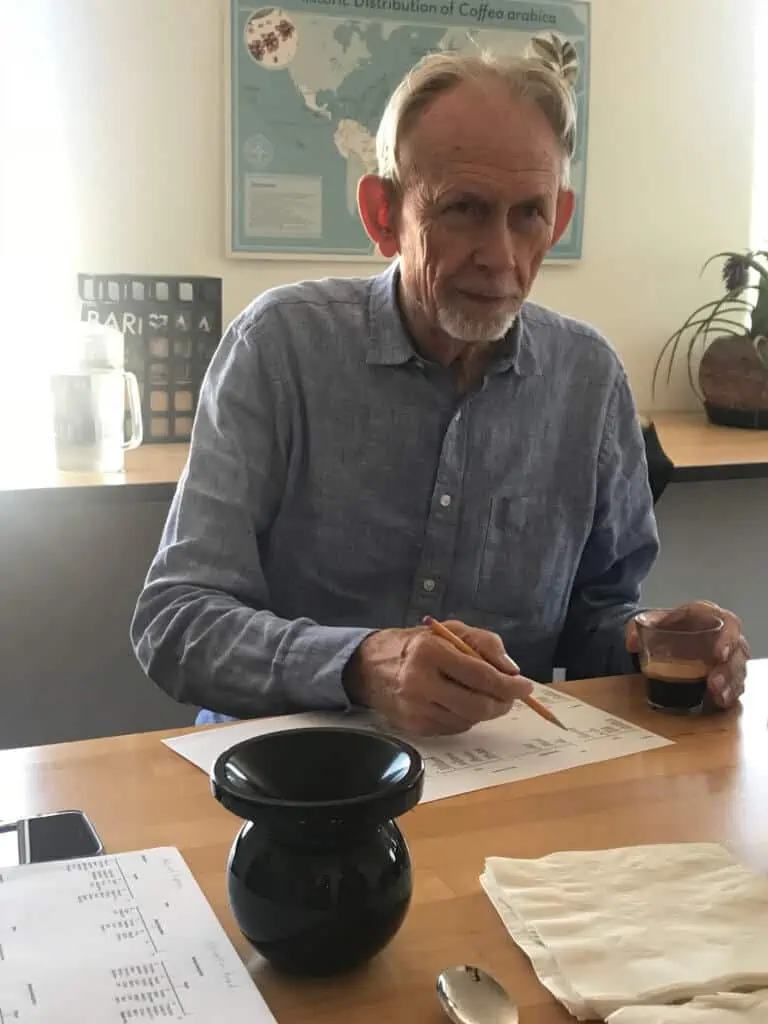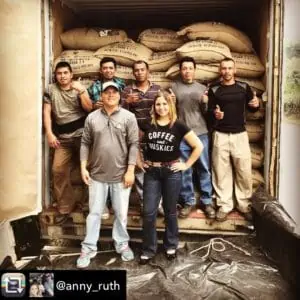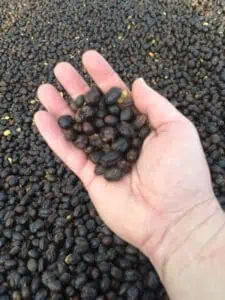I recently led a tasting of fine coffees at a consumer event. Only one of these coffees was natural-processed, i.e., had been prepared at the mill by drying the coffee seeds or beans inside the whole fruit. The other samples were all washed coffees, processed by drying the beans after the fruit skin and flesh had been removed. The washed method is the traditional norm for fine coffee in most coffee-growing regions in the world. The coffee seeds or beans dry faster after the soft fruit skin and flesh have been stripped from them, and there is less danger of the slowly drying fruit spoiling the taste of the coffee by fermenting, mildewing or rotting around the beans during the drying.

Kenneth Davids, editor-in-chief of Coffee Review, evaluating an espresso. Courtesy of Kim Westerman.
Nevertheless, almost all of the 90 coffee drinkers who attended my tasting preferred the one sample that had been dried inside the fruit by the “natural” method. True, this particular coffee had other things going for it—distinguished tree variety, high growing elevation—but so did the other samples we tasted. It appears that the overwhelming majority liked this specific coffee mainly because the act of drying the beans inside the fruit had turned the cup lush, fruity and chocolaty. Drying inside the fruit also tends to fatten mouthfeel and reduce the perceived acidity or tartness of fruit notes, both additional positives for many coffee drinkers.

Floy Andrews, of Bay Area Co-Roasters, evaluating an espresso. Courtesy of Liza Lee.
Not all dried-in-the-fruit coffee tastes good in this particular way, of course. Rather than lush, the fruit notes can taste vaguely rotten, like something recently fished out of the compost. Rather than leaning toward chocolate, the fruit can taste rough, heavy and musty. Other dried-in-the-fruit coffees may emerge nicely from the drying process in an altogether different way: more crisply cocoa-toned than lushly chocolaty. In short, drying coffee in the whole fruit is tricky and hard to control. It can produce everything from a lush, fruity dream to compost in a cup, with lots of possibilities between.
The Natural-Processed Edge in Espresso
But it also happens that attributes like fruit, chocolate, fatter mouthfeel and lower acidity are all particularly appropriate qualifications for coffee when brewed as espresso. So, when Coffee Review tested 35 natural-processed espressos, we harbored rather high expectations.
The three tasters for this report included me, Coffee Review managing editor and Licensed Q-grader Kim Westerman, and Floy Andrews, also a Licensed Q-grader and co-founder of CoRo (Bay Area CoRoasters), a collaborative roasting and educational community space. We conducted the tasting over three days at CoRo and at the Coffee Review lab. Shots were impeccably pulled by master barista Rich Lee, co-founder of Spro Coffee Lab in San Francisco, with expert backup help from Jason Sarley, Coffee Review’s associate editor and in-house barista.

Rich Lee, of SPRO Coffee Lab in San Francisco, the barista for Coffee Review’s tasting of natural-process espressos. Courtesy of Kim Westerman.
We sourced 61 natural-processed single-origin espressos from 46 North American and East Asian roasters. Given the length of time it takes to rigorously test espressos (the grinder needs to be cleaned, precisely recalibrated and several test shots pulled for each sample before the final shots are produced), we were not able to test all of the 61 natural-processed espressos we received. Our principles of elimination were simple. If a roaster sent multiple samples (several did), we tested only one. If a roaster did not send the minimum full pound of beans we requested, enough to calibrate the grinder as well as pull the shots, we did not test that sample.
The Natural Scorecard
Did these natural-processed espressos deliver? Did they offer the fruity and chocolaty, crisply cocoa-toned, or otherwise distinguished espresso experience we were hoping for?

Anny Ruth Pimentel, of Finca Loma La Gloria in El Salvador, and her team. Courtesy of Old Soul Coffee Co.
A very impressive number did. Of the 35 natural-processed espressos we tested, nine scored 93 to 95, while ten more scored 91 to 92. All nine of the 93-through 95-rated espressos are reviewed here. Because five of those top-rated nine samples were Ethiopia coffees, we decided to introduce more Latin America origins into our final report by adding reviews for two of the 92-rated coffees, the Old Soul El Salvador Loma La Gloria Natural and the Argyle Coffee Costa Rica Tirra Natural, as well as for the highest rated Brazil, the nut- and spice-toned, 91-rated Auto Coffee Brazil Fazenda Sertãozinho. Brazil natural-process coffees are widely used in espresso blends worldwide, so we wanted to include at least one coffee from that origin in this month’s reviews.
Natural Quality and Character
What can we say about these natural-processed espressos and, perhaps by extension, about fine natural-processed espressos from contemporary specialty roasters in general? Are they likely to please from a consumer perspective?
Coffee Quality: Reassuring. Despite the tricky nature of drying coffee in the fruit, fundamental coffee quality overall was quite reassuring. Only two of the 35 espressos we tested hinted at green coffee faults of the kind often associated with natural-processed coffees. Many were fruity, but none were over-the-top fermenty. It appears that a consumer buying a natural-processed espresso from a top roaster is likely to buy quality as well as distinction.
Coffee Character: Flamboyant. The best of these espressos were rather broadly stated in their appeal. They typically offered the excitement of complexly layered fruit and chocolate, frequently complicated by floral top notes, and often supported by backgrounded cedary aromatic wood and savory spice. Those who associate espresso with the suave, understated character of Illy Caffè, for example, may be surprised by the assertively original, even flamboyant profiles of many of the espressos reviewed here.
A Natural-Processed Espresso Lexicon
Here is a very general vocabulary describing some of the sensory tendencies among the natural-processed espressos we reviewed.
Chocolate and More Chocolate. Descriptors for chocolate appear, often prominently, in 11 of our 12 reviews. Dark chocolate (most often), chocolate fudge, baker’s chocolate, and in one review, roasted cacao nib, the term we use for a crisp, nut-like chocolate. Probably the most explicit chocolate notes surfaced in the two splendid naturals from Costa Rica branded by their producer as “Perla Negra”: the deeply expressed, darkish-medium-roasted, 95-rated Durango Coffee Perla Negra (co-taster Floy Andrews called the lavish chocolate and fruit in this one “milk chocolate and blueberry pie”) and the similarly complex but much lighter-roasted, brighter 94-rated Magnolia Coffee Perla Negra. These coffees brought a clean, controlled, elegantly chocolate-and-fruit-toned natural character to the classic high-grown profile we associate with Costa Rica and the Caturra variety of Arabica. The 93-rated Kickapoo Coffee Ethiopia Gede Natural displayed a dramatic chocolate character as well, expressed with particular delicacy and grace (co-taster Floy Andrews again: “super balanced” and “a coffee for lovers.”)

“Perla Negra” coffee drying at Finca Las Lajas farm in Costa Rica. Courtesy of Magnolia Coffee.
Fruit. Descriptors for fruit varied greatly from espresso to espresso, but fruit was prominent in all, with a particular emphasis on berries and stone fruit, and less on the citrus notes often associated with wet-processed or washed coffees.
Flowers, Musk and Herb. The five espressos reviewed this month produced from natural-processed Ethiopia coffees were predictably more varied and unexpected in their aromatic character than the six produced from Latin America origins, doubtless owing to the influence of Ethiopia’s largely traditional, genetically varied, often locally indigenous tree varieties. Floral notes were common among the Ethiopias, leaning (probably owing to the influence of the natural processing) toward the sweet and heavyish or the musky. Both of the 95-rated Taiwanese espressos, the Small Eyes Café Gesha Village Lot #25 (produced from the celebrated and still pricy Gesha variety of Arabica) and the Taokas Banko Gotiti showed, amid an exhilarating range of aromas and flavor, the sweet, pungent, rather carnal notes associated with musk. In the case of the Taokas Banko Gotiti, we decided to associate this note with the odor of cannabis flower, which for us has a musky though still fresh aroma, more pungently floral than animal. The Kakalove Café Natural Sidamo Twakok (94) offered a lesson in the pleasures of brisk, crisp coffee character: lavender, dried strawberry, pungent sandalwood, unsweetened chocolate.
Brightness, Acidity. The sweet-tart, often citrusy sensation coffee professionals call acidity (we tend to call it brightness), can be a polarizing sensation in espresso. A coffee that is zesty and refreshing when brewed as drip or French press may come across as sharp and biting when brewed as espresso. Natural processing generally tends to round brightness or acidity, hence the widespread use of natural-processed coffees, particularly Brazils, in espresso blends.
Skillfully conducted medium to medium-dark roasts also can reduce acidy brightness. Interestingly, the three top-rated samples reviewed this month on an average were a bit darker roasted than is usual for coffees that attract high ratings at Coffee Review.

Pulling espresso shots at CoRo (Bay Area Co-Roasters) in Berkeley, CA. Courtesy of Kim Westerman.
Perhaps the brightest sample we review this month is the medium-roasted, 94-rated Dragonfly Yemen, a coffee that should please espresso drinkers who enjoy a complexly stated high-toned fruit in their straight shot or cappuccino. The 94-rated Revel Coffee Ethiospro Blend, a slyly-named blend of all natural-processed coffees from Ethiopia, displayed a rather bright profile as well, although the brightness came enveloped in an intricately original matrix of floral and spearmint notes. Finally, to fill out the bright-side candidates, the 92-rated Old Soul El Salvador Loma La Gloria Natural showed a classic sweet-tart character, with a crisply dry almond and cocoa nuance that bloomed and sweetened elegantly in cappuccino-scaled milk.
Fruit Ferment. If the sugars in the fruit begin to ferment during the drying phase of natural-processing, the result can range from pleasing notes suggesting wine or spirits to sensations that can read as composty or outright foul if the ferment gets completely out of hand. Two of the samples reviewed this month showed a slight, and, for us, pleasing shimmer of sweet ferment. In the PT’s Coffee Granja La Esperanza Tres Dragones Natural (93), an unusual natural coffee from Colombia, we associated this note with brandy; in the Argyle Coffee Costa Rica Tirra Natural (92) we could have associated it with a range of spirits notes, but decided on the scent of aged grappa. The important takeaway is that, in both cases, we found the spirits-like hints pleasingly supported and nuanced the general ripe-fruit character of the coffees.
Thanks to …

The team for Coffee Review’s natural-processed espresso tasting event: Kim Westerman, Kenneth Davids, Jason Sarley, Floy Andrews, Rich Lee. Courtesy of James Parrish.
Co-taster Floy Andrews for her skilled participation in our testing process and spirited contributions to our review language. In her pre-coffee life Floy was a successful attorney. She now combines her extensive business management experience with well-honed sensory skills and a passion for coffee as co-founder and leader of Bay Area CoRoasters (CoRo), the vibrant and growing collaborative community center in Berkeley, California for roasting, packaging and sourcing fine specialty coffee.
CoRo for providing the ideal tools and setting for this tasting.
Rich Lee, the prodigiously experienced barista and dynamic co-founder of SPRO Coffee Lab in San Francisco, for pulling most of the shots for our testing. SPRO co-founders Rich and Liza Lee are mounting an innovative, free-spirited barista competition for the San Francisco coffee community and consumers called Creatures of Habit on Saturday, September 22nd, 2018.










